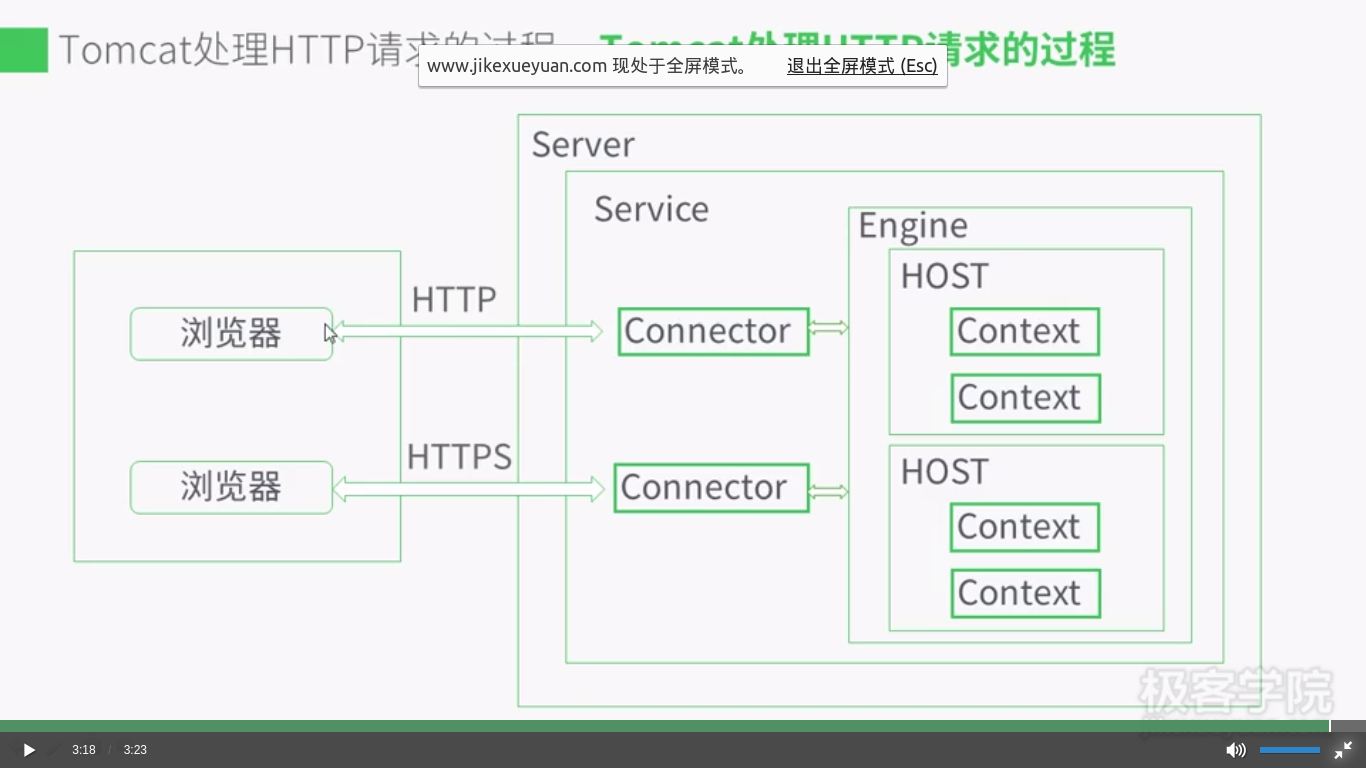[转]TOMCAT原理以及处理HTTP请求的过程、ContextPath ServletPath
一、TOMCAT
1 - Tomcat Server的组成部分
1.1 - Server
A Server element represents the entire Catalina servlet container. (Singleton)
<Server port="8005" shutdown="SHUTDOWN" debug="0">
<Server>属性含义:
--------------------------------------------------------------
className :指定实现org.apache.catalina.Server接口的类,默认值为org.apache.catalina.core.StandardServer.
port :指定Tomcat服务器监听shutdown命令的端口.终止Tomcat服务运行时,必须在Tomcat服务器所在的机器上发出Shutdown命令.该属性是必须设定的.
shutdown :指定终止Tomcat服务器运行时,发给Tomcat服务器的shutdown监听端口的字符串.该属性是必须设定的.
1.2 - Service
A Service element represents the combination of one or more Connector components that share a single Engine
Service是这样一个集合:它由一个或者多个Connector组成,以及一个Engine,负责处理所有Connector所获得的客户请求
<Service>元素由org.apache.catalina.Service接口定义,它包含一个<Engine>元素,以及一个或多个<Connector>元素,这些<Connector>元素共享一个<Engine>元素. 例如,在范例文件中配置了两个<Service>元素
<Service name="Catalina">
name="Apache">
第一个<Service>处理所有直接由Tomcat服务器接收的Web客户请求,第二个<Service>处理由Apache服务器转发过来的Web客户请求.
<Service <Service>属性含义:
--------------------------------------------------------------
className :指定实现org.apache.catalina.Service接口的类,默认值为org.apache.catalina.core.StandardService.
name :定义Service的名字.
1.3 - Connector
一个Connector将在某个指定端口上侦听客户请求,并将获得的请求交给Engine来处理,从Engine处获得回应并返回客户
TOMCAT有两个典型的Connector,一个直接侦听来自browser的http请求,一个侦听来自其它WebServer的请求
Coyote Http/1.1 Connector 在端口8080处侦听来自客户browser的http请求
Coyote JK2 Connector 在端口8009处侦听来自其它WebServer(Apache)的servlet/jsp代理请求
1.4 - Engine
The Engine element represents the entire request processing machinery associated with a particular Service
It receives and processes all requests from one or more Connectors
and returns the completed response to the Connector for ultimate transmission back to the client
Engine下可以配置多个虚拟主机Virtual Host,每个虚拟主机都有一个域名
当Engine获得一个请求时,它把该请求匹配到某个Host上,然后把该请求交给该Host来处理
Engine有一个默认虚拟主机,当请求无法匹配到任何一个Host上的时候,将交给该默认Host来处理
1.5 - Host
代表一个Virtual Host,虚拟主机,每个虚拟主机和某个网络域名Domain Name相匹配
每个虚拟主机下都可以部署(deploy)一个或者多个Web App,每个Web App对应于一个Context,有一个Context path
当Host获得一个请求时,将把该请求匹配到某个Context上,然后把该请求交给该Context来处理
匹配的方法是“最长匹配”,所以一个path==""的Context将成为该Host的默认Context
所有无法和其它Context的路径名匹配的请求都将最终和该默认Context匹配
1.6 - Context
一个Context对应于一个Web Application,一个Web Application由一个或者多个Servlet组成
Context在创建的时候将根据配置文件$CATALINA_HOME/conf/web.xml和$WEBAPP_HOME/WEB-INF/web.xml载入Servlet类
当Context获得请求时,将在自己的映射表(mapping table)中寻找相匹配的Servlet类
如果找到,则执行该类,获得请求的回应,并返回
假设来自客户的请求为:
http://localhost:8080/wsota/wsota_index.jsp
1) 请求被发送到本机端口8080,被在那里侦听的Coyote HTTP/1.1 Connector获得
2) Connector把该请求交给它所在的Service的Engine来处理,并等待来自Engine的回应
3) Engine获得请求localhost/wsota/wsota_index.jsp,匹配它所拥有的所有虚拟主机Host
4) Engine匹配到名为localhost的Host(即使匹配不到也把请求交给该Host处理,因为该Host被定义为该Engine的默认主机)
5) localhost Host获得请求/wsota/wsota_index.jsp,匹配它所拥有的所有Context
6) Host匹配到路径为/wsota的Context(如果匹配不到就把该请求交给路径名为""的Context去处理)
7) path="/wsota"的Context获得请求/wsota_index.jsp,在它的mapping table中寻找对应的servlet
8) Context匹配到URL PATTERN为*.jsp的servlet,对应于JspServlet类
9) 构造HttpServletRequest对象和HttpServletResponse对象,作为参数调用JspServlet的doGet或doPost方法
10)Context把执行完了之后的HttpServletResponse对象返回给Host
11)Host把HttpServletResponse对象返回给Engine
12)Engine把HttpServletResponse对象返回给Connector
13)Connector把HttpServletResponse对象返回给客户browser
执行流程

Tomcat处理http的请求处理过程(来自极客学院)

二、Context Path、Servlet Path、Path info
|-- Context Path --|-- Servlet Path -|--Path Info--|
http://www.myserver.com /mywebapp /helloServlet /hello
|-------- Request URI ----------------------------|
Remember the following three points:
1. Request URI = context path + servlet path + path info.
2. Context paths and servlet paths start with a / but do not end with it.
3. HttpServletRequest provides three methods getContextPath(),
getServletPath() and getPathInfo() to retrieve the context path,
the servlet path, and the path info, respectively, associated with a request.
Identifying the servlet path Servlet 路径匹配
To match a request URI with a servlet, the servlet container follows a simple algorithm.
Once it identifies the context path, if any, it evaluates the remaining part of the
request URI with the servlet mappings specified in the deployment descriptor, in the
following order. If it finds a match at any step, it does not take the next step.
1 The container tries to match the request URI to a servlet mapping. If it finds a
match, the complete request URI (except the context path) is the servlet path. In
this case, the path info is null. 精确匹配优先
2 It tries to recursively match the longest path by stepping down the request URI
path tree a directory at a time, using the / character as a path separator, and determining
if there is a match with a servlet. If there is a match, the matching part
of the request URI is the servlet path and the remaining part is the path info. 最长匹配
3 If the last node of the request URI contains an extension (.jsp, for example),
the servlet container tries to match it to a servlet that handles requests for the
specified extension. In this case, the complete request URI is the servlet path
and the path info is null.扩展匹配,如果url最后一段包含扩展,容器将会根据扩展选择合适的servlet。
4 If the container is still unable to find a match, it will forward the request to the
default servlet. If there is no default servlet, it will send an error message indicating
the servlet was not found.默认或报错
<servlet-mapping>
<servlet-name>RedServlet</servlet-name>
<url-pattern>/red/*</url-pattern>
</servlet-mapping>
<servlet-mapping>
<servlet-name>RedServlet</servlet-name>
<url-pattern>/red/red/*</url-pattern>
</servlet-mapping>
<servlet-mapping>
<servlet-name>RedBlueServlet</servlet-name>
<url-pattern>/red/blue/*</url-pattern>
</servlet-mapping>
<servlet-mapping>
<servlet-name>BlueServlet</servlet-name>
<url-pattern>/blue/</url-pattern>
</servlet-mapping>
<servlet-mapping>
<servlet-name>GreenServlet</servlet-name>
<url-pattern>/green</url-pattern>
</servlet-mapping>
<servlet-mapping>
<servlet-name>ColorServlet</servlet-name>
<url-pattern>*.col</url-pattern>
</servlet-mapping>
Request URI Servlet Used Servlet Path Path Info
/colorapp/red RedServlet /red null
/colorapp/red/ RedServlet /red /
/colorapp/red/aaa RedServlet /red /aaa
/colorapp/red/blue/aa RedBlueServlet /red/blue /aa
/colorapp/red/red/aaa RedServlet /red/red /aaa
/colorapp/aa.col ColorServlet /aa.col null
/colorapp/hello/aa.col ColorServlet /hello/aa.col null
/colorapp/red/aa.col RedServlet /red /aa.col
/colorapp/blue NONE(Error message)
/colorapp/hello/blue/ NONE(Error message)
/colorapp/blue/mydir NONE(Error message)
/colorapp/blue/dir/aa.col ColorServlet /blue/dir/aa.col null
/colorapp/green GreenServlet /green null
[转]TOMCAT原理以及处理HTTP请求的过程、ContextPath ServletPath的更多相关文章
- TOMCAT原理详解及请求过程(转载)
转自https://www.cnblogs.com/hggen/p/6264475.html TOMCAT原理详解及请求过程 Tomcat: Tomcat是一个JSP/Servlet容器.其作为Ser ...
- TOMCAT原理详解及请求过程
Tomcat: Tomcat是一个JSP/Servlet容器.其作为Servlet容器,有三种工作模式:独立的Servlet容器.进程内的Servlet容器和进程外的Servlet容器. Tomcat ...
- Tomcat学习(二)------Tomcat原理详解及请求过程
Tomcat: Tomcat是一个JSP/Servlet容器.其作为Servlet容器,有三种工作模式:独立的Servlet容器.进程内的Servlet容器和进程外的Servlet容器. Tomcat ...
- 网站开发进阶(四)Tomcat Server处理一个http请求的过程
Tomcat Server处理一个http请求的过程 假设来自客户的请求为: http://localhost:8080/wsota/wsota_index.jsp 1) 请求被发送到本机端口8080 ...
- Tomcat Server处理一个http请求的过程
Tomcat Server处理一个http请求的过程 假设来自客户的请求为: http://localhost:8080/wsota/wsota_index.jsp 1) 请求被发送到本机端口8080 ...
- Spring框架系列(14) - SpringMVC实现原理之DispatcherServlet处理请求的过程
前文我们有了IOC的源码基础以及SpringMVC的基础,我们便可以进一步深入理解SpringMVC主要实现原理,包含DispatcherServlet的初始化过程和DispatcherServlet ...
- Tomcat目录结构及Tomcat Server处理一个http请求的过程
http://blog.sina.com.cn/s/blog_62cb15980101jh9x.html 1.Tomcat的结构概述 Tomcat服务器是由一系列可配置的组件构成,其核心组件是 ...
- Tomcat 原理篇
TOMCAT 原理篇一.Tomcat 组成(Tomcat 由以下组件组成) 1.server a) Server是一个Catalina Servlet容器: b) Server 可以包含一个或多个se ...
- tomcat原理
1 - Tomcat Server的组成部分 1.1 - Server A Server element represents the entire Catalina servlet containe ...
随机推荐
- 磁盘IO子系统学习资料
1.http://www.ibm.com/developerworks/cn/linux/l-cn-read/ (IBM read系统调用剖析) 2.http://lenky.info/arch ...
- MySQL对于有大量重复数据表的处理方法
需要在MySQL的一张innodb引擎的表(tableA)上添加一个唯一索引(idx_col1_u).但是对于每个key(col1)表中已经有大量重复数据.此时,做数据的手工清理,或者SQL处理是非常 ...
- 利用bind搭建dns
下载bind,我下载的是bind-9.3.1rc1.tar.gz 我下载的文件放在/root目录下 进入目录解压缩 [root@linux root]#tar xfz bind-9.3.1rc1.ta ...
- 权限控制框架Spring Security 和Shiro 的总结
关于权限控制,一开始感觉比较难,后来先是接触了Spring Security 学起来也比较吃力,再是学习了Shiro,感觉简单很多. 总体来说这些框架,主要做了两个事情 Authentication: ...
- Spring 面试复习
1 singleton 和 prototype singleton作用域:当把一个Bean定义设置为singleton作用域是,Spring IoC容器中只会存在一个共享的Bean实例,并且所有对 ...
- Android 进程和线程模型
Android进程模型 在安装Android应用程序的时候,Android会为每个程序分配一个Linux用户ID,并设置相应的权限,这样其它应用程序就不能访问此应用程序所拥有的数据和资源了. 在 Li ...
- hdoj 3549 Flow Problem(最大网络流)
题目链接:http://acm.hdu.edu.cn/showproblem.php?pid=3549 思路分析:该问题为裸的最大网络流问题,数据量不大,使用EdmondsKarp算法求解即可:需要注 ...
- DRP过后,感受知识间的通性
DRP视频看了不短的时间,真正开始DRP的时间是7月17号,至今两个月了.由于暑假期间英语的学习占得时间比较多,所以DRP视频进行的很慢.9月11号看完了DRP所有的视频,这个项目完成后最大的感受是: ...
- codeigniter IE浏览器下无法登录的解决的方法
站点搬迁到新的server后,CI 框架做的站点IE浏览器下无法登录.登录时候採用CI自带的SESSION机制,事实上是以COOKIE保存. 网上搜索到IE浏览器不支持域名存在- _. 不是这个原因, ...
- HDU 1711 Number Sequence KMP
题目地址: http://acm.hdu.edu.cn/showproblem.php?pid=1711 AC代码: #include <iostream> #include <cs ...
